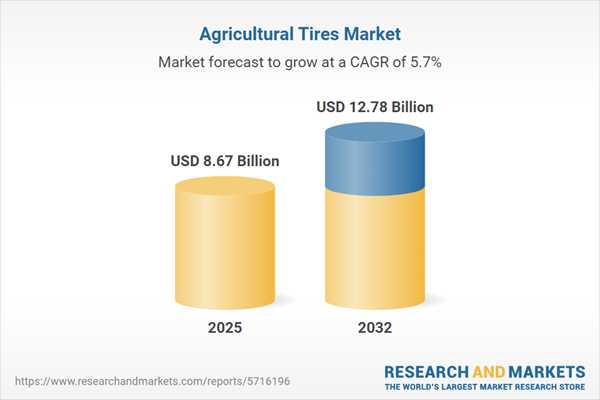Speak directly to the analyst to clarify any post sales queries you may have.
Senior decision-makers in the agricultural tires sector face a challenging market climate requiring proactive approaches to procurement, supplier evaluation, and operational resilience. Strategic adaptation is becoming essential as shifting farming needs, technology innovation, and evolving risks reshape expectations for reliability and performance.
Agricultural Tires Market Snapshot: Size, Growth, and Innovation
The global agricultural tires market reached USD 8.19 billion in 2024, with projected growth to USD 8.67 billion in 2025 and an anticipated market size of USD 12.78 billion by 2032. This growth, reflected in a 5.71% CAGR, is driven by expansive mechanization in agribusiness, rapid deployment of next-generation tire technologies, and increasing end-user demand for durability and high-performance traction. Procurement teams are tasked with meeting highly varied equipment needs, driving agile sourcing and proactive supplier engagement. Evolving climate patterns and changes in crop scheduling require adaptive sourcing and risk management to maintain operational productivity and competitive positioning within the agricultural tires segment.
Scope & Segmentation: Strategic Intelligence for Procurement
This report delivers actionable insight for procurement leaders navigating the complex agricultural tires landscape. Detailed segmentation enables tailored sourcing and supplier strategies to address diverse operational and regional needs:
- Application Segments: Assess procurement requirements for tractors, combine harvesters, implements, irrigation systems, and sprayers. Evaluating compatibility with mixed-age fleets and multi-crop operations helps maximize asset utilization and lifecycle value.
- Product Types: Compare bias, radial, and solid tire designs. Matching tire type to workload and field conditions supports both standard and specialized operational needs, increasing equipment effectiveness and reducing downtime.
- Distribution Channels: Choose from aftermarket, dealership, e-commerce, and OEM pathways. Integrating these channels strengthens fleet management, technical oversight, and ensures continuity of service across a wide range of equipment.
- Ply Ratings: Select appropriate ply ratings, from two-ply up to sixteen-ply, to align with specific machinery demands and support both durability and cost-predictability in ongoing maintenance plans.
- Rim Sizes: Source tires suitable for sub-thirty inch, thirty to forty-five inch, and over forty-five inch rims, optimizing for equipment fit as standards and regional machinery preferences continue to evolve.
- Regions: Address unique compliance requirements and environmental factors in the Americas, Europe, Middle East and Africa, and Asia-Pacific. Tailoring procurement to local standards and climates ensures sustained productivity.
- Leading Companies: Review offerings from Michelin SCA, Bridgestone Corporation, Continental Aktiengesellschaft, Trelleborg AB, Titan International Inc, The Goodyear Tire & Rubber Company, Yokohama Rubber Co Ltd, Balkrishna Industries Limited, Sumitomo Rubber Industries Ltd, and Mitas a.s., with a focus on reliability, sustainability, and innovation benchmarks.
Key Takeaways for Senior Decision-Makers
- Deployment of advanced materials and structural engineering is elevating efficiency, enabling fleets to adapt across varying terrain and farming conditions.
- Procurement practices now increasingly prioritize tires with renewable material content and circular design principles, supporting enterprise sustainability goals and regulatory compliance.
- The implementation of smart tire solutions, including embedded sensors, empowers predictive maintenance capabilities and streamlined fleet operations with reduced unplanned downtime.
- Digital procurement tools are simplifying sourcing workflows; nonetheless, ongoing collaboration with knowledgeable dealers remains essential for technical validation and service reliability.
- Robust risk management depends on thorough supplier vetting and development of contingency frameworks, ensuring procurement can flexibly respond to regulatory adjustments and local climate volatility.
Tariff Impact: Navigating U.S. Policy Shifts
Recent U.S. tariffs imposed on imported agricultural tires require procurement leaders to implement enhanced compliance protocols and adjust sourcing processes. Strategies such as revising inventory levels, renegotiating supplier contracts, and adopting supply chain monitoring tools can help secure ongoing fleet readiness and minimize operational disruptions caused by policy changes.
Methodology & Data Sources
This report’s findings are grounded in validated market metrics, regulatory analysis, and input from senior executives and industry experts. The methodology emphasizes best practices across materials engineering, manufacturing, and logistics, aligning with current requirements specific to agricultural supply chains.
Why This Report Matters
- Empowers supply chain and procurement professionals with practical guidance on addressing regulatory shifts and mitigating agricultural sector supply risks.
- Provides a technology-focused and regional view that supports the development of robust sourcing strategies while maintaining supplier quality standards.
- Facilitates benchmarking and continuous improvement through targeted peer comparisons and actionable insights.
Conclusion
By applying these insights, procurement executives can reinforce supply chain resilience, optimize sourcing, and sustain operational continuity in the continuously evolving agricultural tires market.
Additional Product Information:
- Purchase of this report includes 1 year online access with quarterly updates.
- This report can be updated on request. Please contact our Customer Experience team using the Ask a Question widget on our website.
Table of Contents
3. Executive Summary
4. Market Overview
7. Cumulative Impact of Artificial Intelligence 2025
Companies Mentioned
The companies profiled in this Agricultural Tires market report include:- Michelin SCA
- Bridgestone Corporation
- Continental Aktiengesellschaft
- Trelleborg AB
- Titan International, Inc.
- The Goodyear Tire & Rubber Company
- Yokohama Rubber Co., Ltd.
- Balkrishna Industries Limited
- Sumitomo Rubber Industries, Ltd.
- Mitas a.s.
Table Information
| Report Attribute | Details |
|---|---|
| No. of Pages | 199 |
| Published | October 2025 |
| Forecast Period | 2025 - 2032 |
| Estimated Market Value ( USD | $ 8.67 Billion |
| Forecasted Market Value ( USD | $ 12.78 Billion |
| Compound Annual Growth Rate | 5.7% |
| Regions Covered | Global |
| No. of Companies Mentioned | 11 |









